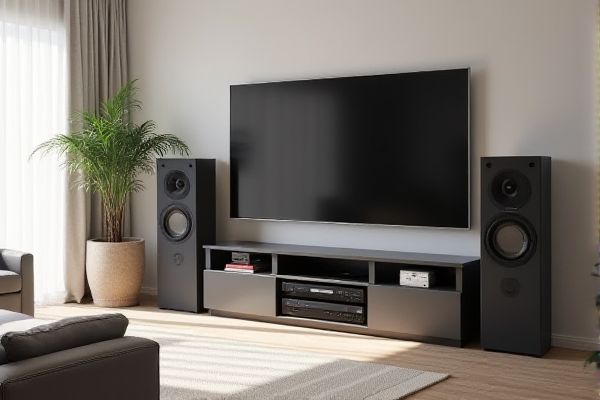
Choosing between a low-profile media stand and a tall media tower depends on your room layout and storage needs, with low-profile stands offering a sleek, unobtrusive design ideal for small spaces, while tall media towers provide ample vertical storage for extensive media collections. Discover which option best suits your style and functionality requirements by reading the rest of this article.
Table of Comparison
| Feature | Low-Profile Media Stand | Tall Media Tower |
|---|---|---|
| Height | Short, close to floor level | Tall, vertical structure |
| Storage Capacity | Limited shelves, ideal for minimal media | Multiple shelves, large media collection storage |
| Space Utilization | Better for wide rooms, uses horizontal space | Optimizes vertical space in small rooms |
| Accessibility | Easy access to items at eye-level | Requires reaching higher shelves |
| Design Style | Modern, minimalist look | Classic, space-saving design |
| Weight Capacity | Supports lighter equipment | Stronger, supports heavier devices |
| Setup Location | Under TV or against low walls | Corner spaces or tight areas |
| Price Range | Typically lower cost | Usually higher cost due to size |
Introduction to Media Furniture: Low-Profile Stands vs Tall Towers
Low-profile media stands offer a minimal footprint with sleek design, ideal for smaller spaces and a modern aesthetic. Tall media towers provide ample vertical storage, making them suitable for organizing multiple devices, DVDs, and gaming consoles efficiently. Your choice depends on spatial constraints and storage needs, balancing accessibility with visual impact.
Space Efficiency: Maximizing Room Layout
Low-profile media stands maximize room layout by occupying minimal vertical space, making your area feel more open and spacious. Tall media towers offer vertical storage solutions, ideal for rooms with limited floor space but ample height, optimizing storage without crowding the floor. Choosing between them depends on your room's dimensions and how you prioritize horizontal versus vertical space efficiency.
Aesthetic Appeal: Modern vs Traditional Looks
Low-profile media stands offer a sleek, modern aesthetic ideal for minimalist interiors, emphasizing clean lines and unobtrusive design that complements contemporary decor. Tall media towers provide a traditional look with a vertical structure that showcases a classic, robust presence, often incorporating decorative elements and more intricate craftsmanship. Choosing between the two depends on whether the space values a streamlined, airy feel or a more substantial, classic furniture statement.
Storage Capacity: Comparing Options
Low-profile media stands offer limited storage capacity, typically accommodating a few devices and media accessories, making them ideal for compact spaces. Tall media towers provide significantly more vertical storage, with multiple shelves and compartments designed to house a larger collection of DVDs, gaming consoles, and audio equipment. Choosing between the two depends on the need for maximizing storage space versus maintaining a minimal footprint in the room.
Accessibility and Convenience
Low-profile media stands offer higher accessibility by keeping devices and media within easy reach and at eye level, reducing strain during use. Tall media towers provide more storage capacity but often require bending or reaching, which may be less convenient for frequent access. Your choice depends on whether you prioritize ease of access or maximizing storage space in your media setup.
Cable Management Solutions
Low-profile media stands typically offer discreet cable management with hidden channels and back panels designed to keep wires organized and out of sight, ideal for maintaining a minimalist aesthetic in your space. Tall media towers provide vertical cable routing options, allowing more room to bundle and separate cables from various devices, which can help prevent tangling and improve airflow. Choosing the right solution depends on your device setup and how much accessibility you need for cable adjustments.
Durability and Stability
Low-profile media stands typically offer increased stability due to their wider base and lower center of gravity, reducing the risk of tipping over. Tall media towers, while space-efficient, may compromise durability as their slender structure can be more prone to wobbling or damage under heavier loads. Choosing materials like solid wood or metal enhances durability for both styles, but low-profile stands inherently provide greater stability for heavier equipment.
Safety Considerations for Families
Low-profile media stands offer enhanced safety for families by minimizing the risk of tipping, making them ideal for homes with young children or pets. Tall media towers, while space-efficient, pose a greater hazard due to their height and potential instability, requiring secure anchoring to prevent accidents. Your family's safety is best ensured by choosing furniture that prioritizes stability and reduces the risk of injury in active household environments.
Cost Comparison: Budgeting for Media Furniture
Low-profile media stands typically offer a more affordable option with simpler designs and fewer materials, making them budget-friendly for basic media setups. Tall media towers, often constructed with additional compartments and built-in storage, tend to be pricier but provide enhanced organizational features and vertical space efficiency. Choosing between the two depends on the balance between upfront cost and functional storage needs within your media room budget.
Making the Right Choice for Your Home
Choosing between a low-profile media stand and a tall media tower depends on your room's layout and storage needs. Low-profile stands offer a sleek, unobtrusive design ideal for small spaces and provide easy access to electronics without overpowering the room. Tall media towers maximize vertical storage, perfect for organizing multiple devices and decor in larger areas, helping you keep your entertainment center tidy and efficient.
 homyna.com
homyna.com